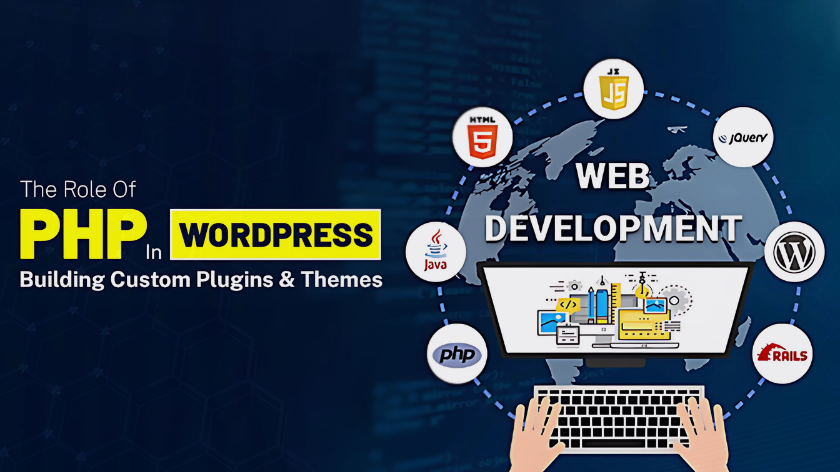WordPress, the world’s most widely used content management system (CMS), is powered primarily by PHP. This versatile scripting language enables developers to build custom plugins and themes, extending WordPress’s functionality and enhancing its design. “Whether you’re a developer or a business owner, understanding PHP’s role in WordPress helps you maximize its potential. PHP ensures flexibility and scalability, allowing businesses to tailor their websites to specific needs. By mastering PHP, developers can unlock limitless opportunities for website customization.
Why PHP is Essential for WordPress Development
PHP powers WordPress, enabling dynamic functionality and smooth database integration. Here’s why it’s indispensable:
- Server-Side Execution: PHP operates on the server, generating dynamic content before delivering it to users.
Example: A PHP script retrieves the latest blog posts from a database and displays them dynamically on the homepage.
This ensures faster processing, improved security, and a seamless user experience by minimizing unnecessary client-side computations.
- Database Management: WordPress relies on MySQL, and PHP handles executing queries, retrieving data, and storing user input.
Example: When a user submits a comment, PHP processes and stores it in the database. Efficient database management ensures smooth content updates and retrieval. Optimized queries enhance performance and reduce website loading times.
- Customization Capabilities: PHP empowers developers to create unique WordPress experiences through custom themes and plugins.
Example: An eCommerce site can use a custom PHP plugin to generate personalized product recommendations based on user behavior.
Custom PHP scripts allow businesses to develop tailored features, ensuring better user engagement and a competitive edge.
Developing Custom WordPress Plugins with PHP
Custom plugins extend WordPress functionality beyond its core features. Here’s how PHP contributes to plugin development:
1. Plugin Architecture & Initialization
A plugin begins with a PHP file containing metadata and hooks that integrate it with WordPress.
Example: A PHP script defining a plugin that adds a custom widget to display social media feeds.
A well-structured plugin ensures easier maintenance and seamless updates. Properly organizing the code reduces potential conflicts with other plugins and themes.
2. Leveraging Hooks & Filters
Hooks enable developers to modify WordPress behavior without altering core files.
Example: A PHP action hook that automatically adds a watermark to uploaded images. Hooks and filters offer a modular approach to extending WordPress functionality. Proper utilization enables developers to introduce dynamic features while maintaining core stability.
3. Creating Shortcodes & Widgets
PHP facilitates the development of shortcodes and widgets, enhancing content customization.
Example: A custom shortcode in PHP that embeds a dynamic pricing table on any page. Shortcodes simplify content management, making adding complex elements easier for non-technical users. Widgets improve usability by providing drag-and-drop functionality.
Crafting Custom WordPress Themes with PHP
Themes define a website’s design, and PHP plays a crucial role in its development.
1. Theme File Structure
A theme includes PHP templates that define the site’s layout and appearance.
Example: The header.php file contains site-wide elements such as logos and navigation menus. A well-organized theme structure enhances readability and scalability, allowing for effortless modifications.
2. The Loop & Dynamic Content
PHP manages WordPress’s main loop, which dynamically fetches and displays content.
Example: The index.php file uses PHP to retrieve and display the latest blog posts. The Loop is essential for content-driven websites, enabling real-time content updates. Optimizing The Loop leads to faster page loads and improved user experience.
3. Custom Template Tags
Developers use PHP to create reusable functions within themes.
Example: A PHP function that displays related posts at the end of each article. Custom template tags improve modularity, reusability, and consistency in theme development.
Security & Performance Best Practices
While PHP offers flexibility, adhering to best practices is crucial for security and performance.
- Input Sanitization: Prevents SQL injections and cross-site scripting (XSS) attacks.
Example: Using esc_html() to sanitize user-generated comments before displaying them. Proper input validation reduces security vulnerabilities, protecting against data breaches and cyber threats.
- Query Optimization: Reduces database load to enhance website performance.
Example: Caching frequent database queries to improve page loading speed. Efficient database queries prevent server overload, ensuring a smooth user experience. Utilizing caching mechanisms like WP_Query enhances efficiency.
- PHP Version Updates: Ensures compatibility with the latest WordPress versions.
Example: Upgrading to PHP 8+ for better performance and security improvements. Regular PHP updates provide access to new features and security patches, ensuring long-term stability and optimal functionality.
Conclusion
PHP continues to be the foundation of WordPress customization, empowering developers to build dynamic themes and powerful plugins. Whether creating unique features for an online store or enhancing user experience through innovative designs, PHP provides endless possibilities for WordPress development. Mastering PHP grants developers complete control over WordPress sites, leading to better functionality and long-term business success.
Looking for expert WordPress development? XcelTec specializes in delivering high-performance WordPress solutions tailored to your needs. Get in touch today, and let’s create something exceptional!
For More Information: https://www.xceltec.com/
 :
https://in.pinterest.com/xceltec0192/
:
https://in.pinterest.com/xceltec0192/


